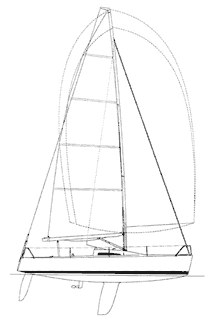Donovan 27
PHRF Racer
The hull is pretty typical of what we see today in racing boats. The BWL is narrow with considerable flare to the topsides. The bilge turn is firm and there is a wee hint of deadrise to the midsection. There is plenty of rocker to this canoe body and that's a function of the displacement. Using a removable 600-pound internal ballast piece, the displacement jumps from a light PHRF weight of 3,700 pounds (D/L of 130) to a MORC weight of 4,300 pounds (D/L of 151.17 using the same waterline length). In either ballast configuration, this is not a light boat by today's standards.
The entry is very fine and while the plan view drawing appears to show a fairly full line at the deck, the photos do not. Photos show the bow cleaving the water. The 1,500-pound keel is a straight fin with no bulb and 6 feet of draft. Note the curvature on both the leading and trailing edges of the keel.
This rig is big but not crazy big like we are seeing on some one-designs. In MORC configuration the SA/D is 22.2 and in PHRF configuration 24.55. The mainsail is loose footed with about 6 inches of overlap on the backstay. For MORC racing the spinnaker will be hoisted about 24 inches above the hounds, but for PHRF you can go with a bigger, masthead spinnaker. The spreaders are only slightly swept and mainsail draft adjustments will be made with the backstay.
This is a nice sized boat for racing. The spinnaker goes up fast, hand over hand, and it comes down fast too. When the flotsam hits the fan it's a relatively small chunk of flotsam that is easily overcome with well applied manpower. Mast and boom are both carbon fiber.
An alumnus of Bruce Farr's office, Donovan knows a thing or two about deck layouts on racing boats. Fashions come and go, but ergonomics remain constant. This cockpit layout has been perfected over the years and today it's almost universal on racing boats. Its key is to make lines lead logically so a new crewmember can acclimate to the boat quickly. Crew weight is kept in the most advantageous position (out of the stern) and crew movement is minimized. This is a big cockpit for a 27-footer, but that's a function of ergonomics and not LOA.
The small, bullet-shaped cabintrunk covers a couple of settee berths. The head is in the fo'c'sle. There has been no attempt to make this interior cruiser-friendly. This is a sails-and-sandwiches interior layout.
A 20-horsepower Yanmar diesel with saildrive gives this boat an honest 7 knots under power.
This boat would be fun to race. You can get it ready in five minutes and put it away with a wash down in 10 minutes. Unfortunately it enters a niche in the market chock full of good boats.
Time will tell if the Donovan 27 is anything special.

Comments